There is something special about dainty garden flowers. Their blossoms are delicate but also sturdier than they look! Small annual flowers bring an element of sweetness to pots, borders, and beds. Many varieties are excellent as a ground cover too. And while they might be small, annual flowers with petite blooms can pack a punch when it comes to color and beauty. So enjoy our list of 10 small annual flowers for your garden and containers! We’ve selected varieties that are usually easy to find and easy to grow for beginner gardeners.
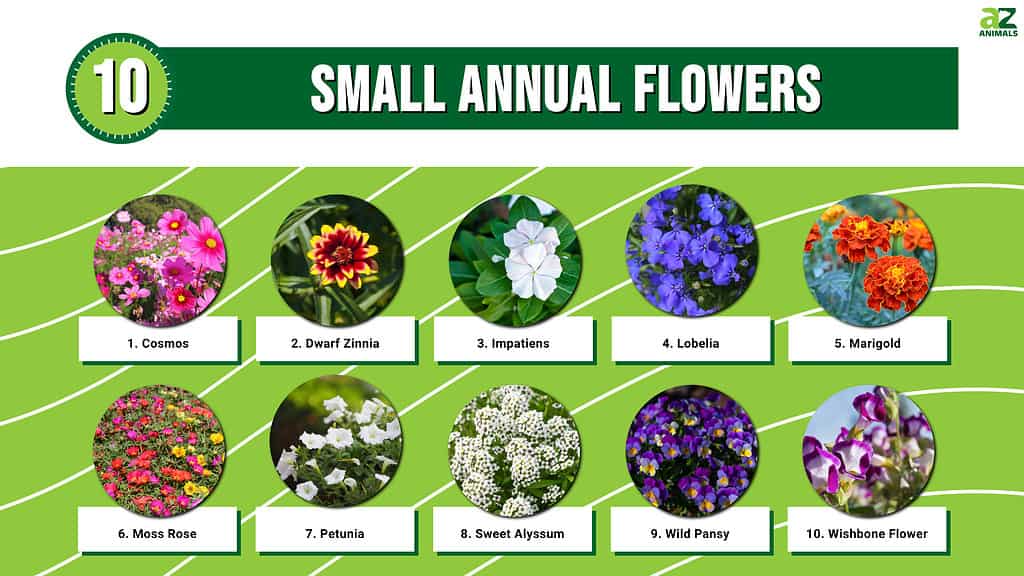
1. Cosmos

A recent study featured in Plant Foods for Human Nutrition showed that extracts from
Cosmos bipinnatuscontain antioxidants.
©iStock.com/Passakorn_14
Botanical name: Cosmos bipinnatus
Common names: Cosmos, sulfur cosmos, Mexican aster
USDA hardiness zones: 2 to 11
Sun exposure: Full sun preferred
Mature size: Up to 1 foot tall, 4 feet wide
Bloom time: Summer through fall
Flower colors: Orange, yellow, pink, red, white, maroon, violet
Cosmos flowers are annuals that are easy to grow from seed. The small blooms of cosmos plants look like daisies and come in various colors. Cosmos grow best in full sun but can handle some light shade. They are drought tolerant and tend to do better in average to poor soil versus fertilized soil. Most gardening pros recommend that you don’t fertilize cosmos flowers because fertile soil weakens the plants.
Not only are cosmos sweet and small flowers to plant in your garden, but they also might have health benefits! A recent study featured in Plant Foods for Human Nutrition showed that extracts from Cosmos bipinnatus contain antioxidants. The extracts studied were from cosmos flowers in the following colors: pink, orange, violet, and white.
2. Dwarf Zinnia
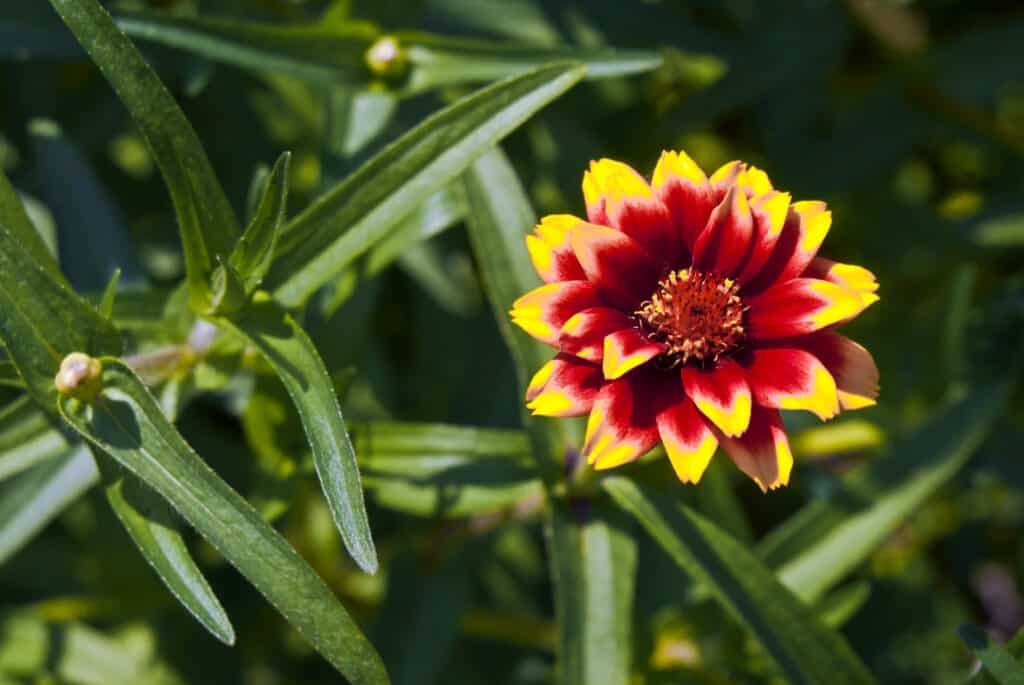
When it comes to planting, dwarf zinnias are pretty easygoing.
©Nick Pecker/Shutterstock.com
Botanical name: Zinnia haageana
Common names: Dwarf zinnia, Mexican zinnia, miniature zinnia
USDA hardiness zones: 2 to 12
Sun exposure: Full sun to partial shade
Mature size: Up to 18 inches high, 12 inches wide
Bloom time: Mid-summer through fall
Flower colors: White, yellow, orange, pink, red, lavender
Dwarf zinnias are annuals that are native to Mexico. These cute and colorful annual flowers resemble traditional zinnias but are much smaller. Dwarf zinnias have fluffy pom-pom shapes, grow best in full sun, and attract many pollinators to your garden. Hummingbirds, bees, and butterflies all love zinnia blooms.
When it comes to planting, dwarf zinnias are pretty easygoing. Dwarf zinnias can handle most types of soil as long as it is well-draining. One thing to remember is that zinnias (any size) don’t like to be transplanted, so it’s best to sow them directly. Or start your dwarf zinnia plants indoors in peat pots, then transfer them — peat pot and all — into beds and containers. In addition, encourage more blooms throughout the season by deadheading (removing) spent flowers.
3. Impatiens
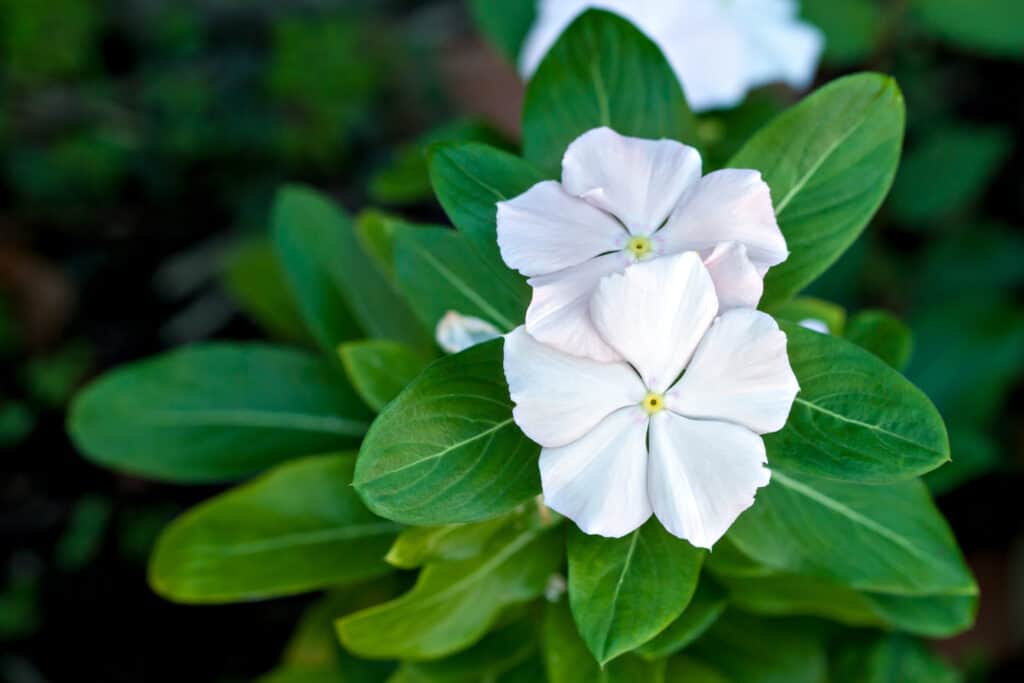
Impatiens prefer cooler temperatures and moist soil.
©Tikta Alik/Shutterstock.com
Botanical name: Impatiens walleriana
Common names: Busy lizzie, impatiens, touch-me-not
USDA hardiness zones: 10 to 11
Sun exposure: Partial sun to full shade
Mature size: Up to 24 inches tall and wide
Bloom time: Spring until fall
Flower colors: Lavender, red, pink, purple, white, orange, bi-color
Also known as touch-me-nots, impatiens are perfect for shady areas of the garden. Their delicate blooms are shaped like stars or trumpets and come in many colors. Pots full of impatiens are easy to grow and maintain on porches and decks, making them a perfect small annual flower for beginning gardeners and children.
Impatiens prefer cooler temperatures and moist soil. So water them regularly, or they will wilt quickly in hot, dry conditions. Also, suppose you live in an area with sweltering summers. In that case, it’s best to plant impatiens in spring and enjoy them until early summer. Or try planting them in a shady spot that gets some afternoon relief from the sun.
4. Lobelia
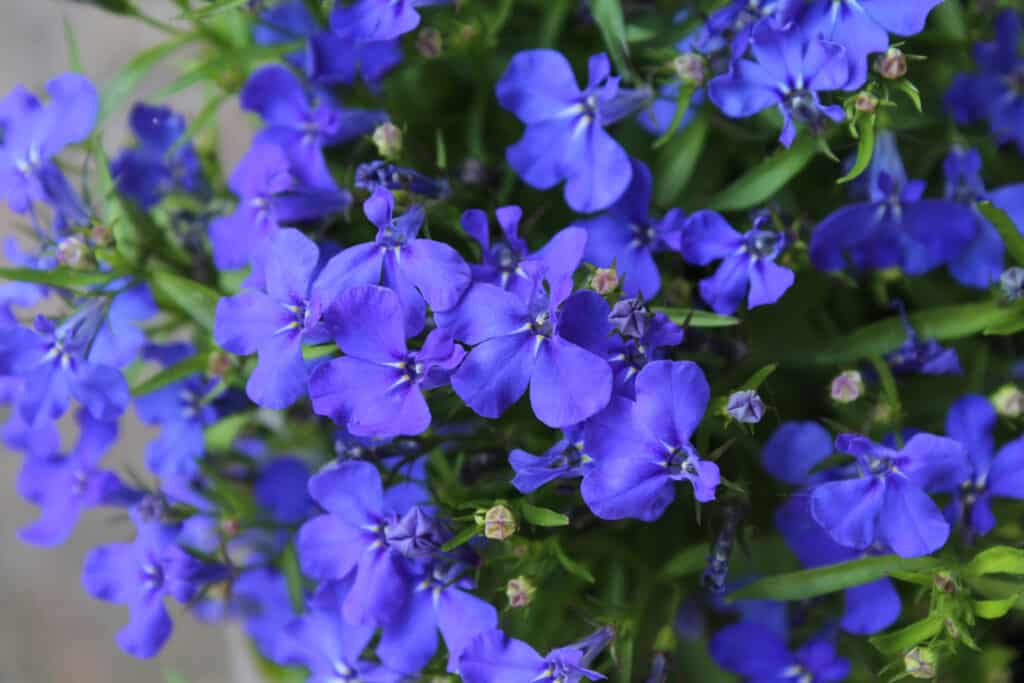
Many lobelia cultivars (varieties) are tender perennials grown as annuals, but some are less hardy than others.
©iStock.com/Imladris01
Botanical name: Lobelia erinus
Common names: Annual lobelia, edging lobelia, trailing lobelia
USDA hardiness zones: 2 to 11
Sun exposure: Full sun to partial shade
Mature size: Up to 12 inches tall, 2 feet wide
Bloom time: Spring to fall, pausing mid-summer
Flower colors: Blue, lavender, mauve, pink, white, bi-color
Lobelia is a trailing plant with bright and tubular small blooms. This pretty annual flower is excellent for hanging baskets, window boxes, and other containers where the plant cascades down the sides. Lobelia plants grow best in full sun or partial shade, and these trailing beauties attract many butterflies.
Many lobelia cultivars (varieties) are tender perennials grown as annuals, but some are less hardy than others. To grow lobelias as an annual:
- Plant them in rich and well-drained soil.
- Pinch back the plant branches to encourage bushier growth and more flowers.
- Remove any spent blooms to keep the plant looking tidy and promote continuous flowering.
5. Marigold
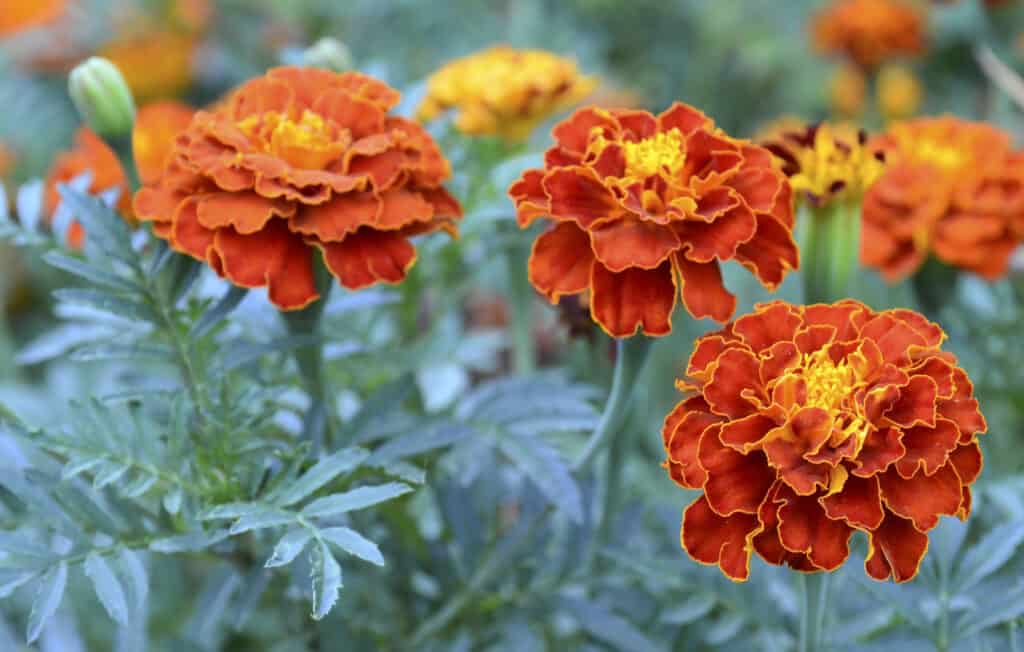
Marigolds are bright and cheery flowers that are easy to care for.
©iStock.com/svf74
Botanical name: Tagetes patula
Common name: French marigold
USDA hardiness zones: 9 to 11
Sun exposure: Full sun is best
Mature size: Up to 1 foot tall and wide
Bloom time: Summer through fall
Flower colors: Yellow, orange, red, bi-color
Marigolds have bright, cheery colors and are easy to maintain. The marigold we’re suggesting here is the French marigold, known for its small flowers, compact plants, and spicy scent. This small annual flower is easy to grow and comes mainly in orange, yellow, and red. In addition, a French marigold’s fluffy round blooms grow to 2 inches and brighten garden beds from summer through fall.
The best soils for French marigolds are light and sandy. They also prefer full sun but might tolerate very light shade. If possible, wait to plant marigolds until the soil warms in late spring or early summer. Once they are established, French marigolds are pretty drought-tolerant. Although, they will flower best if you keep them evenly moist — especially during hot, dry weather.
6. Moss Rose
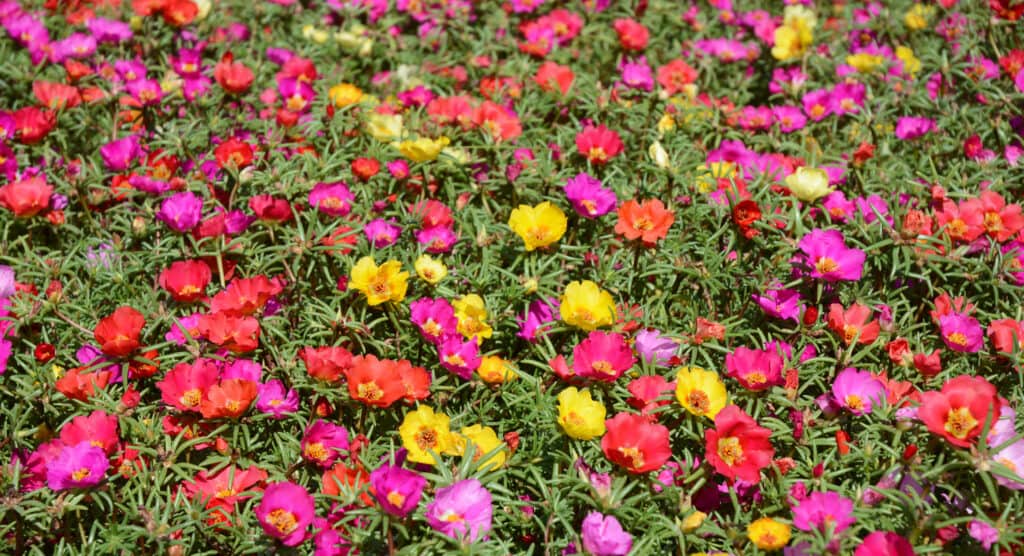
Drought-tolerant moss rose prefers soil that is sandy and well-drained.
©iStock.com/Lex20
Botanical name: Portulaca grandiflora
Common names: Moss rose, sun rose, rock rose
USDA hardiness zones: 2 to 12
Sun exposure: Full sun is best
Mature size: Up to 6 inches high and 24 inches wide
Bloom time: Late spring through fall
Flower colors: Pink, red, white, yellow, orange
The moss rose is known for its moss-like leaves and round ruffled blossoms. It’s another trailing plant great for ground cover since it blankets the ground in a mass of dense foliage. Indeed, this low-growing annual flower is a self-seeding creeper. In warm growing zones, moss rose plants grow as perennials and expand over more ground yearly.
Drought-tolerant moss rose prefers soil that is sandy and well-drained. It’s a great flower choice for hot, dry areas of the garden where other plants wilt or struggle. Since this plant is so small, it looks best en masse in beds and borders. You can also grow moss roses in containers where they spill over the sides like a miniature waterfall.
7. Petunia

The petunia plant grows in a mound of blooms until stems get leggy and begin to trail.
©pakn/Shutterstock.com
Botanical name: Petunia x atkinsiana
Common names: Petunia
USDA hardiness zones: Most zones as annuals
Sun exposure: Full sun preferred
Mature size: Up to 18 inches high, 48 inches wide
Bloom time: Spring through fall
Flower colors: Blue, yellow, pink, purple, red, white, bi-color
We wouldn’t be surprised if the petunia is one of the top 10 most popular annual flowers of all time. Its popularity comes from being easy to grow in many hardiness zones, plus petunias come in many different colors. In addition, petunias are widely available and bloom all season if you prune them several times during the growing season.
The petunia plant grows in a mound of blooms until stems get leggy and begin to trail. If you don’t want your petunias to cascade from pots and beds, cut their branches back about 25%-50% as needed.
Petunias prefer soil that is high in organic matter and drains well. They also do best with a good amount of fertilizer to keep them blooming from spring to fall. If you live in a warm climate, petunias will grow as perennials, but in cooler temperatures, they are annuals.
One popular variety of petunia is the ‘Supertunia Vista Bubblegum.’ This award-winning petunia cultivar is light pink and fragrant and creates a pretty trailing plant in containers and window boxes.
8. Sweet Alyssum

Sweet Alyssum grows in large bunches of small white flowers.
©iStock.com/Sundry Photography
Botanical name: Lobularia maritima
Common names: Sweet alyssum, bunny tails
USDA hardiness zones: 5 to 9
Sun exposure: Full sun to partial shade
Mature size: Up to 8 inches tall, 12 inches wide
Bloom time: Spring through summer
Flower colors: White, pink, lavender, peach
The sweet alyssum is an annual spreading flower perfect for rock gardens or as a border plant. Its tiny four-petaled flowers are usually white, which is where their common name of bunny tails originates. However, some alyssum cultivars (varieties) are available in additional colors like pink and lavender.
A bed of sweet alyssum plants is dense with tiny blooms, making these small annual flowers lovely as ground cover. In addition to providing a blanket of blossoms, sweet alyssum is also very fragrant. Bees and tiny nectar-loving insects adore this flower’s honey-like scent, and so will you!
9. Wild Pansy
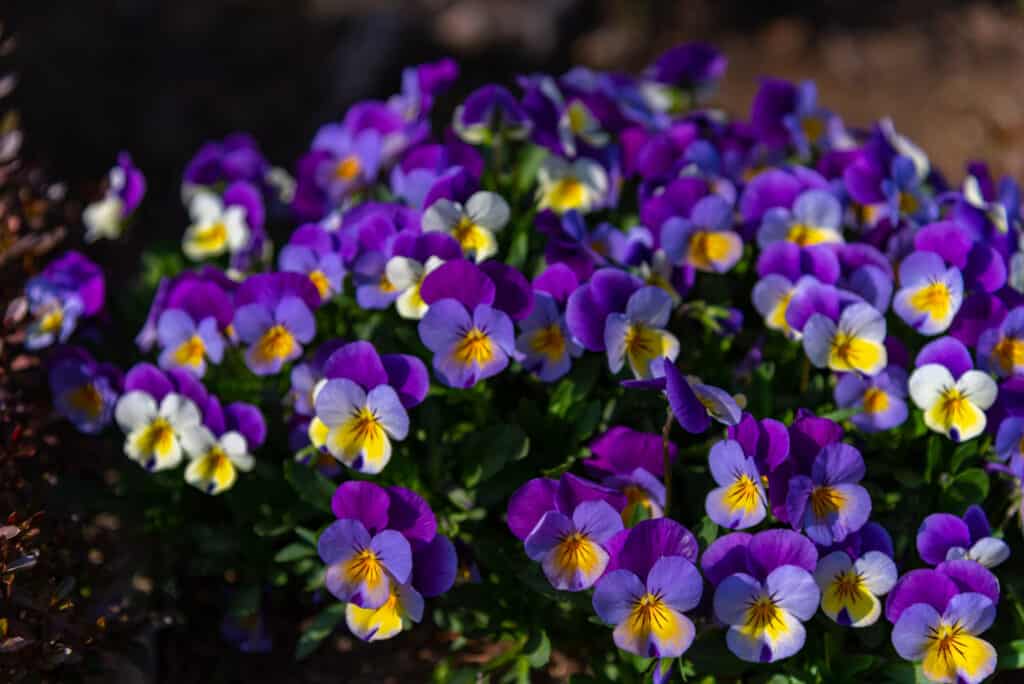
Wild Pansy tolerates some sun but prefers partial shade, especially in hot climates.
©Shawn.ccf/Shutterstock.com
Botanical name: Viola tricolor
Common names: Wild pansy, Johnny Jump up, Heart’s Ease
USDA hardiness zones: 3 to 9
Sun exposure: Partial shade preferred
Mature size: Up to 1 foot tall and wide
Bloom time: Spring through summer
Flower colors: Tricolor with purple, yellow, and white
Wild pansies or Johnny Jump up flowers are a favorite among gardeners because of their cheerful, dainty faces. This variety of pansy has three colors on each blossom – purple, yellow, and white. The three-tone blooms of wild pansies pop up in spring and last until early summer.
Johnny Jump ups grow best in cooler temperatures. They tolerate some sun but prefer partial shade, especially in hot climates. These flowers are also quite tolerant of cold weather and might start blooming in spring when snow is still on the ground.
These delicate small annual flowers self-seed and spread easily. So if you’re in a zone where wild pansies grow as perennials, you might find them popping up next year in surprising new areas of your property. And these sweet flowers love to rise up between cracks in concrete patios and walkways.
10. Wishbone Flower
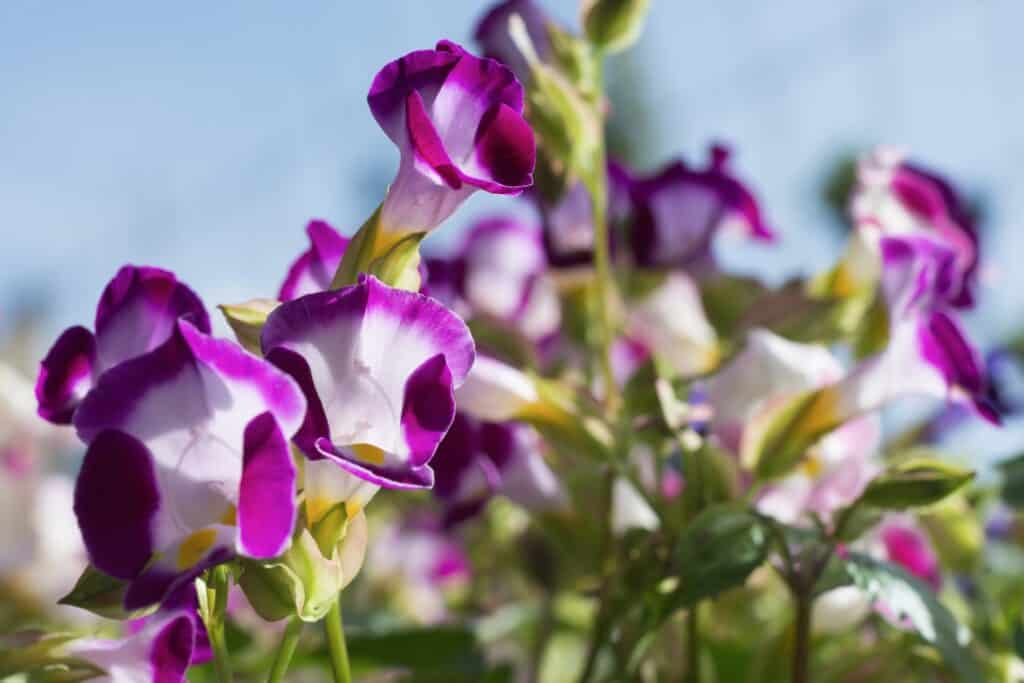
Wishbone flowers don’t grow very tall (up to 12 inches high).
©Isnan Wijarno/Shutterstock.com
Botanical name: Torenia fournieri
Common names: Wishbone flower, bluewing
USDA hardiness zones: 2 to 11
Sun exposure: Partial sun to full shade
Mature size: Up to 1 foot tall and 9 inches wide
Bloom time: Summer through fall
Flower colors: Blue, purple, pink, white, yellow, bi-color
The wishbone flower has two-tone trumpet-shape blooms commonly found in blue or purple with white. And this pretty plant loves the shade! As a result, wishbone flowers grow beautifully in pots on the deck and shady areas in the garden where you’d love to add a little color.
Wishbone flowers don’t grow very tall (up to 12 inches high). So they make great filler flowers in bouquets or planted en masse in landscape beds. In addition, these annuals can rebloom throughout the season if you regularly deadhead spent flowers.
Summary of 10 Small Annual Flowers
Here’s a recap of 10 small flowering annuals that we took a look at:
| Number | Flower | USDA Hardiness Zone | Colors |
|---|---|---|---|
| 1 | Cosmos | 2 to 11 | Orange, yellow, pink, red, white, maroon, violet |
| 2 | Dwarf Zinnia | 2 to 12 | White, yellow, orange, pink, red, lavender |
| 3 | Impatiens | 10 to 11 | Lavender, red, pink, purple, white, orange, bi-color |
| 4 | Lobelia | 2 to 11 | Blue, lavender, mauve, pink, white, bi-color |
| 5 | Marigold | 9 to 11 | Yellow, orange, red, bi-color |
| 6 | Moss Rose | 2 to 12 | Pink, red, white, yellow, orange |
| 7 | Petunia | Most zones | Blue, yellow, pink, purple, red, white, bi-color |
| 8 | Sweet Alyssum | 5 to 9 | White, pink, lavender, peach |
| 9 | Wild Pansy | 3 to 9 | Tricolor with purple, yellow, and white |
| 10 | Wishbone Flower | 2 to 11 | Blue, purple, pink, white, yellow, bi-color |
Conclusion
Small annual flowers like impatiens, wild pansies, and wishbone flowers brighten shady corners and paths. Pretty petunias and moss rose flowers trail out of sunny window boxes and pots. And sweet alyssum covers the ground in blankets of tiny white blooms! No matter which small annual flowers you choose, every one of them is a sweet treasure in your garden.
The photo featured at the top of this post is © Isnan Wijarno/Shutterstock.com
Sources
- Almanac, Available here: https://www.almanac.com/plant/zinnias#:~:text=It's%20recommended%20that%20you%20grow,quickly%20in%20the%20right%20conditions.
- Utah State University Extension, Available here: https://extension.usu.edu/yardandgarden/research/cosmos-in-the-garden#:~:text=Do%20not%20fertilize%20cosmos.,amended%20with%20fertilizer%20and%20compost.
- The Missouri Botanical Garden, Available here: https://www.missouribotanicalgarden.org/PlantFinder/PlantFinderDetails.aspx?kempercode=b733
Thank you for reading! Have some feedback for us? Contact the AZ Animals editorial team.






